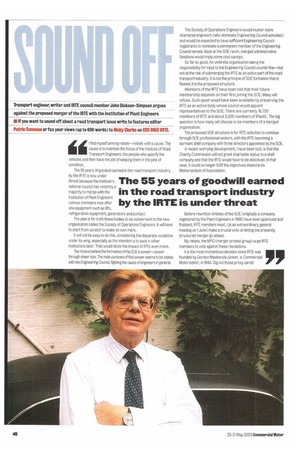I find myself among rebels—rebels with a cause. The cause
Page 48

If you've noticed an error in this article please click here to report it so we can fix it.
is to maintain the focus of the Institute of Road Transport Engineers: the people who specify the vehicles and then have the job of keeping them in the pink of condition.
The 55 years of goodwill earned in the road transport industry by the IRTE is now under threat because the Institute's national council has voted by a majority to merge with the Institution of Plant Engineers (whose members look after site equipment such as lifts, refrigeration equipment, generators and pumps).
The plan is for both these bodies to be subservient to the new organisation called the Society of Operations Engineers. It will have to start from scratch to make its own mark.
It will not be easy to do this, considering the disparate vocations under its wing, especially as the intention is to suck in other institutions later. That would dilute the impact of 1RTE even more.
The motive behind the formation of the SOE is power—power through sheer size. The main purpose of that power seems to be status with the Engineering Council, fighting the cause of engineers in general. The Society of Operations Engineers would muster more chartered engineers (who dominate Engineering Council activities) and would be expected to have sufficient Engineering Council registrants to nominate a permanent member of the Engineering Council senate. Back at the SOE ranch, merged administrative functions would imply some cost savings.
So far so good. An umbrella organisation taking the responsibility for input to the Engineering Council sounds fine—but not at the risk of submerging the IRTE as an active part of the road transport industry. It is not the principle of SUE formation that is flawed; it is the proposed structure.
Members of the IRTE have been told that their future membership depends on their first joining the SOE. Many will refuse. Such upset would have been avoidable by preserving the IRTE as an active body whose council would appoint representatives to the SOE. There are currently 16,700 members of IRTE and about 5,000 members of IPlantE. The big question is how many will choose to be members of a merged organisation.
The proposed SOE structure is for IRTE activities to continue through SOE professional sectors, with the IFITE becoming a dormant shell company with three directors appointed by the SOE.
A recent worrying development, I have been told, is that the Charity Commission will not grant charitable status to a shell company and that the IRTE would have to be dissolved. In that case, it could no longer fulfil the objectives stated in its Memorandum of Association.
Before rewritten Articles of the SOE (originally a company registered by the Plant Engineers in 1998) have been approved and finalised, IRTE members must, (at an extraordinary general meeting on 1 June) make a crucial vote on letting the presently structured merger go ahead.
My rebels, the MPG (merger protest group) urge IRTE members to vote against these resolutions.
It is the most momentous decision since IRTE was founded by Gordon Mackenzie Junner, a Commercial Motoreciftor, in 1944. Dig out those proxy cards!
















































































































